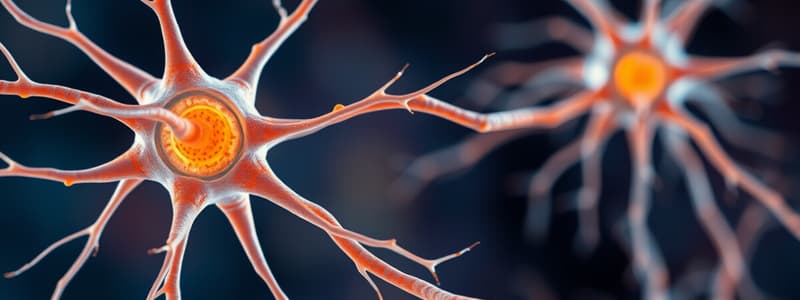Podcast
Questions and Answers
What are afferent neurons responsible for?
What are afferent neurons responsible for?
- Stimulating muscles for movement
- Carrying nerve impulses away from the CNS
- Communication within the brain and spinal cord
- Carrying nerve impulses towards the CNS (correct)
What are efferent neurons responsible for?
What are efferent neurons responsible for?
- Carrying nerve impulses towards the CNS
- Sensing distortion in body tissues
- Communicating between sensory inputs and motor outputs
- Carrying nerve impulses away from the CNS (correct)
What are mechanoreceptors?
What are mechanoreceptors?
Sensory receptors that sense distortion in body tissues.
What is the function of interneurons?
What is the function of interneurons?
The rate of enzyme activity depends on the concentration of the enzyme and the __________.
The rate of enzyme activity depends on the concentration of the enzyme and the __________.
What does Km refer to in enzyme kinetics?
What does Km refer to in enzyme kinetics?
What is the function of the endoderm germ layer?
What is the function of the endoderm germ layer?
What does the mesoderm develop into?
What does the mesoderm develop into?
What does the ectoderm develop into?
What does the ectoderm develop into?
Flashcards are hidden until you start studying
Study Notes
Neuron Types
- Afferent Neurons: Sensory neurons that transmit nerve impulses from sensory stimuli to the central nervous system (CNS) and brain.
- Efferent Neurons: Motor neurons that carry neural impulses away from the CNS to muscles, facilitating movement.
Sensory Receptors
- Mechanoreceptors: Specialized sensory receptors that detect distortion in body tissues caused by pressure or movement.
Interneurons
- Neurons located within the brain and spinal cord that process information by connecting sensory inputs with motor outputs, playing a crucial role in reflexes and complex behaviors.
Enzyme Kinetics
- Enzyme activities depend on the concentrations of both the enzyme and its substrate.
- Environmental factors such as temperature and pH levels significantly influence enzyme performance.
Km (Michaelis-Menten Constant)
- Represents the substrate concentration at which the reaction velocity is half of the maximum velocity (Vmax).
Germ Layers
- Endoderm: The innermost germ layer responsible for forming the lining of the digestive and respiratory systems.
- Mesoderm: The middle germ layer that develops into muscles, and components of the circulatory, reproductive, and excretory systems.
- Ectoderm: The outermost germ layer that gives rise to skin and nervous tissue.
Studying That Suits You
Use AI to generate personalized quizzes and flashcards to suit your learning preferences.



